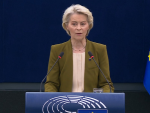New Delhi: China’s economic activity has slowed more than expected last month, with a sharp slump in investment raising hopes for governmental stimulus to keep growth in line with official targets, a report has said.
The annual growth target of the People’s Republic of China (PRC) is around 5 per cent. Industrial output and consumption had their worst month yet this year after a sharp slowdown in July, official data showed.
Production at Chinese factories and mines expanded 5.2 per cent last month from a year earlier, marking the smallest gain since August 2024, according to data released by the National Bureau of Statistics, and cited by a Financial Review report.
Chinese manufacturers are awaiting more clarity on a US trade deal and domestic demand curbed by a volatile job market and property crisis.
A 5.7 per cent rise was recorded in industrial output in July. Retail sales, a gauge of consumption, expanded 3.4 per cent in August, the slowest pace since November 2024, and cooling from a 3.7 per cent rise in the previous month. Markets had forecasted a gain of 3.9 per cent.
Fixed-asset investment also grew at a slower-than-expected 0.5 per cent pace in the first eight months year-on-year, from 1.6 per cent in January to July, marking its worst performance outside the pandemic.
Analysts said that a strong start early this year keeps the growth targets within reach, but further stimulus support could be needed to ensure a strong finish to the year.
The optimistic forecast is despite the difficulty in gauging the impact of the consumer loan subsidies coming into effect in September.
Multiple reports cited analysts indicating a high possibility for another 10bps rate cut and a 50 bps Reserve Requirement Ratio (RRR) cut in the coming weeks.
India’s GDP growth has rebounded strongly in Q1, and the reforms such as budget tax cuts, rate cuts by the MPC and GST rationalisation have the potential to sustain the growth momentum.
Analysts feel that there is a high likelihood of above 15 per cent growth in corporate earnings in FY27, leading to a turnaround in FPI sentiments.
IANS




















